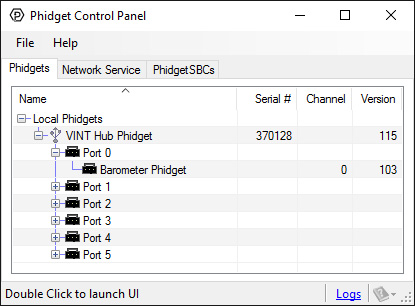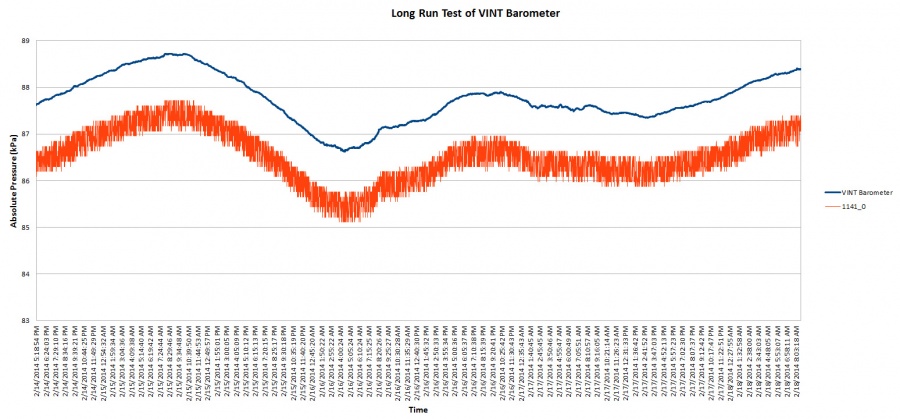PRE1000 User Guide: Difference between revisions
No edit summary |
No edit summary |
||
| (11 intermediate revisions by 3 users not shown) | |||
| Line 1: | Line 1: | ||
__NOINDEX__ | |||
__NOTOC__ | |||
<metadesc>Precisely measure the absolute air pressure from 50 and 110 kPa with the Barometer Phidget. Connects to a port on your VINT Hub.</metadesc> | |||
[[Category:UserGuide]] | [[Category:UserGuide]] | ||
==Part 1: Setup== | |||
{{PT1 Deck Sequence}} | |||
== Part 2: Using Your Phidget == | |||
=== | ===About=== | ||
The Barometer Phidget measures absolute pressures within the range of 50kPa and 110kPa at a resolution of 250 mPa. If you read air pressures outside this range, an error event will trigger. | |||
===Explore Your Phidget Channels Using The Control Panel=== | |||
You can use your Control Panel to explore your Phidget's channels. | |||
'''1.''' Open your Control Panel, and you will find the following channel: | |||
[[Image:PRE1000_Panel.jpg|link=|center]] | |||
'''2.''' Double click on the channel to open the example program. This channel belongs to the '''PressureSensor''' channel class: | |||
{{ | {{UGC-Start}} | ||
{{UGC-Entry|Barometer Phidget:| Measures the air pressure around the PRE1000| | |||
In your Control Panel, double click on "Barometer Phidget": | |||
= | [[Image:PRE1000-PressureSensor.jpg|center|link=]]}} | ||
{{UGC-End}} | |||
{{UG-Part3}} | |||
== Part 4: Advanced Topics and Troubleshooting == | |||
{{UGC-Start}} | |||
{{UGC-Addressing}} | |||
{{UGC-Graphing}} | |||
{{UGC-DataInterval}} | |||
{{UGC-Firmware}} | |||
{{UGC-Entry|Barometric Temperature Correction|| | |||
The PRE1000 reports the absolute pressure of its surroundings; in other words, the pressure compared to a perfect vacuum. If you plan on using this sensor as a barometer, you need to convert to barometric pressure. You can use conversion calculators such as this [http://www.csgnetwork.com/barcorrecthcalc.html above sea level barometer reading correction calculator] to make the adjustment based on your location's elevation. | |||
}} | |||
{{UGC-Entry|Using the PRE1000 as an Altimeter|| | |||
Since the PRE1000 makes absolute pressure measurements, you could use it with a temperature sensor to measure changes in altitude, as long as you know your pressure and height to begin with. The following is the barometric formula: | Since the PRE1000 makes absolute pressure measurements, you could use it with a temperature sensor to measure changes in altitude, as long as you know your pressure and height to begin with. The following is the barometric formula: | ||
::<math>P_h = P_0 e^{\frac{-Mgh}{R^*T}}</math> | ::<math>P_h = P_0 e^{\frac{-Mgh}{R^*T}}</math> | ||
where | where | ||
| Line 46: | Line 57: | ||
:<math>R^*</math> is the universal gas constant (8.3144598 J/(mol*K)) | :<math>R^*</math> is the universal gas constant (8.3144598 J/(mol*K)) | ||
:<math>T</math> is the standard temperature in degrees Kelvin. | :<math>T</math> is the standard temperature in degrees Kelvin. | ||
This formula can be rearranged for <math>h</math> as follows: | This formula can be rearranged for <math>h</math> as follows: | ||
| Line 51: | Line 63: | ||
::<math>h = \frac{R^*T * ln(\frac{P_h}{P_0})}{-Mg}</math> | ::<math>h = \frac{R^*T * ln(\frac{P_h}{P_0})}{-Mg}</math> | ||
}} | |||
{{UGC-Entry|Accuracy|| | |||
A long-run test was performed to compare the accuracy of the | A long-run test was performed to compare the accuracy of the PRE1000 with that of the {{Prod|1141}} - Absolute Gas Pressure Sensor. For 87 hours, both sensors measured the absolute air pressure indoors in the same room, with the same change sensitivity. | ||
[[Image:VINTBAR_graph.jpg|900px|link=|center]] | |||
As you can see, the PRE1000 is significantly less noisy. The average difference between any two successive samples for the 1141 is 237.17Pa, while for the PRE1000, it is 3.19Pa. Both sensors consistently differ by an average of 1.23kPa, but this error could be easily calibrated out due to the consistency of the offset. | |||
}} | |||
{{ | {{UGC-End}} | ||
Latest revision as of 21:18, 17 January 2022
Part 1: Setup
Part 2: Using Your Phidget
About
The Barometer Phidget measures absolute pressures within the range of 50kPa and 110kPa at a resolution of 250 mPa. If you read air pressures outside this range, an error event will trigger.
Explore Your Phidget Channels Using The Control Panel
You can use your Control Panel to explore your Phidget's channels.
1. Open your Control Panel, and you will find the following channel:

2. Double click on the channel to open the example program. This channel belongs to the PressureSensor channel class:
In your Control Panel, double click on "Barometer Phidget":

Part 3: Create your Program
Part 4: Advanced Topics and Troubleshooting
Before you open a Phidget channel in your program, you can set these properties to specify which channel to open. You can find this information through the Control Panel.
1. Open the Control Panel and double-click on the red map pin icon:

2. The Addressing Information window will open. Here you will find all the information you need to address your Phidget in your program.

See the Phidget22 API for your language to determine exact syntax for each property.
Note: Graphing and logging is currently only supported in the Windows version of the Phidget Control Panel.
In the Phidget Control Panel, open the channel for your device and click on the ![]() icon next to the data type that you want to plot. This will open up a new window:
icon next to the data type that you want to plot. This will open up a new window:

If you need more complex functionality such as logging multiple sensors to the same sheet or performing calculations on the data, you'll need to write your own program. Generally this will involve addressing the correct channel, opening it, and then creating an Event Handler and adding graphing/logging code to it.
The quickest way to get started is to download some sample code for your desired programming language and then search google for logging or plotting in that language (e.g. "how to log to csv in python") and add the code to the existing change handler.
Filtering
You can perform filtering on the raw data in order to reduce noise in your graph. For more information, see the Control Panel Graphing page.
Graph Type
You can perform a transform on the incoming data to get different graph types that may provide insights into your sensor data. For more information on how to use these graph types, see the Control Panel Graphing page.
The Change Trigger is the minimum change in the sensor data needed to trigger a new data event.
The Data Interval is the time (in ms) between data events sent out from your Phidget.
The Data Rate is the reciprocal of Data Interval (measured in Hz), and setting it will set the reciprocal value for Data Interval and vice-versa.
You can modify one or both of these values to achieve different data outputs. You can learn more about these properties here.
Firmware Upgrade
MacOS users can upgrade device firmware by double-clicking the device row in the Phidget Control Panel.
Linux users can upgrade via the phidget22admin tool (see included readme for instructions).
Windows users can upgrade the firmware for this device using the Phidget Control Panel as shown below.

Firmware Downgrade
Firmware upgrades include important bug fixes and performance improvements, but there are some situations where you may want to revert to an old version of the firmware (for instance, when an application you're using is compiled using an older version of phidget22 that doesn't recognize the new firmware).
MacOS and Linux users can downgrade using the phidget22admin tool in the terminal (see included readme for instructions).
Windows users can downgrade directly from the Phidget Control Panel if they have driver version 1.9.20220112 or newer:

Firmware Version Numbering Schema
Phidgets device firmware is represented by a 3-digit number. For firmware patch notes, see the device history section on the Specifications tab on your device's product page.

- If the digit in the 'ones' spot changes, it means there have been bug fixes or optimizations. Sometimes these changes can drastically improve the performance of the device, so you should still upgrade whenever possible. These upgrades are backwards compatible, meaning you can still use this Phidget on a computer that has Phidget22 drivers from before this firmware upgrade was released.
- If the digit in the 'tens' spot changes, it means some features were added (e.g. new API commands or events). These upgrades are also backwards compatible, in the sense that computers running old Phidget22 drivers will still be able to use the device, but they will not be able to use any of the new features this version added.
- If the digit in the 'hundreds' spot changes, it means a major change has occurred (e.g. a complete rewrite of the firmware or moving to a new architecture). These changes are not backwards compatible, so if you try to use the upgraded board on a computer with old Phidget22 drivers, it will show up as unsupported in the Control Panel and any applications build using the old libraries won't recognize it either. Sometimes, when a Phidget has a new hardware revision (e.g. 1018_2 -> 1018_3), the firmware version's hundreds digit will change because entirely new firmware was needed (usually because a change in the processor). In this case, older hardware revisions won't be able to be upgraded to the higher version number and instead continue to get bug fixes within the same major revision.
The PRE1000 reports the absolute pressure of its surroundings; in other words, the pressure compared to a perfect vacuum. If you plan on using this sensor as a barometer, you need to convert to barometric pressure. You can use conversion calculators such as this above sea level barometer reading correction calculator to make the adjustment based on your location's elevation.
Since the PRE1000 makes absolute pressure measurements, you could use it with a temperature sensor to measure changes in altitude, as long as you know your pressure and height to begin with. The following is the barometric formula:
where
- is the pressure at height
- is the pressure at height zero
- is the molar mass of earth's air (0.0289644 kg/mol)
- is the gravitational constant (9.80665 m/s^2)
- is the current height
- is the universal gas constant (8.3144598 J/(mol*K))
- is the standard temperature in degrees Kelvin.
This formula can be rearranged for as follows:
A long-run test was performed to compare the accuracy of the PRE1000 with that of the 1141 - Absolute Gas Pressure Sensor. For 87 hours, both sensors measured the absolute air pressure indoors in the same room, with the same change sensitivity.

As you can see, the PRE1000 is significantly less noisy. The average difference between any two successive samples for the 1141 is 237.17Pa, while for the PRE1000, it is 3.19Pa. Both sensors consistently differ by an average of 1.23kPa, but this error could be easily calibrated out due to the consistency of the offset.









